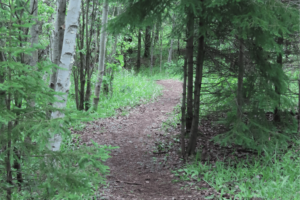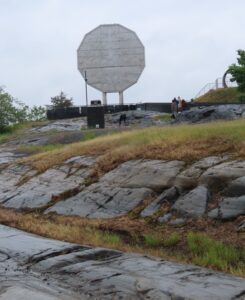Around the World
The Greening of Sudbury: Dr. Jane Goodall’s Hope for Mankind
Sep 2023 | By Pat Brennan
SUDBURY – the world’s best-known environmentalist, Dr. Jane Goodall, says that this Northern Ontario city is one of her best hopes for the future of mankind.
This place once looked like the dark side of the moon, dramatically enough that Apollo astronauts came here to practice exploring the moon’s surface. Today it is the scene of one of the world’s most successful environmental rehabilitations. Once a vast wasteland of black rock, Sudbury is green again.
 To celebrate the overwhelming success of Sudbury’s conservation efforts, Dr. Goodall cut a ribbon last year to open Coniston’s Jane Goodall Environmental Trail. Her trail roams through thick woods which had been one of the ugliest examples of sulphur dioxide’s nasty work.
To celebrate the overwhelming success of Sudbury’s conservation efforts, Dr. Goodall cut a ribbon last year to open Coniston’s Jane Goodall Environmental Trail. Her trail roams through thick woods which had been one of the ugliest examples of sulphur dioxide’s nasty work.
Coniston is a village just east of the city that has now been amalgamated into Greater Sudbury, a region five times bigger than Metro Toronto. It’s here where the conservation began, but also where miners began smelting ore to extract minerals in 1913.
Hundreds of men were hired to push wheelbarrows full of ore, taken from deep in the earth to be dumped on top of stacks of white pine. The stacks of pine were set on fire and burned for three months to draw the sulphur out of the ore, which was then sent through crushing machines to extract nickel, copper, and other minerals.
The clouds of sulphur from the roasting beds smothered the area, killing off all vegetation and poisoning nearby lakes. Millions of white pine trees were harvested to build the roasting pits and support frames in the various mines in the Sudbury basin, reducing forested regions until they all but disappeared.
 Over this long history of mining the region’s rich earth, sulphur dioxide emissions from roasting Sudbury’s rocks to extract nickel, copper, and other rare earth minerals eventually killed off the city’s remaining trees, as well as the grass, lakes, fish – and its people, too.
Over this long history of mining the region’s rich earth, sulphur dioxide emissions from roasting Sudbury’s rocks to extract nickel, copper, and other rare earth minerals eventually killed off the city’s remaining trees, as well as the grass, lakes, fish – and its people, too.
Forty years ago, the city decided it had seen enough. The local government started a multi-billion-dollar program to heal from the environmental devastation of the last century and bring green back to Sudbury… and fish, too. But why are the fish such a big deal?
Within the city of Sudbury there are 330 lakes – more than any other city in Canada – and when she visited the city last year, 88-year-old Jane Goodall was thrilled to see plenty of loons plying those lakes after a resurgence of the local population.
Two loons raising one chick will eat more than 1,000 pounds of fish in a year, and for years, Sudbury lakes contained no fish at all. After being poisoned by sulphonic acid, numbers waned as the many fish species either died off or sought cleaner waters, and in result, the Sudbury basin was devoid of loons.
Now the loons are back because the fish are back; because Sudbury’s air, water, and soil are no longer poisoned. It just goes to show how closely our paths are tied to the world around us – in the delicate balance of nature, impact on one species has an effect on the ecology of an entire region.
Over the past 40 years, more than 10 million trees have been planted in the Sudbury basin to undo the deforestation and rejuvenate the local environment. Before new trees are planted and grass seed spread, the black hills are coated with lime to neutralise the sulphur dioxide acid.
But despite the severe impact Sudbury has suffered, there’s a lot we can learn from this complex history.
The Sudbury basin and its world-class mineral deposits was created about 1.8 billion years ago when a meteorite at least 15 kilometres wide collided with the earth. Debris from the collision was found as far away as Minnesota, and tells scientists a great deal about our planet’s history.
Today, there are at least nine active mines in the Sudbury basin and the Creighton Mine is 2.5 kilometres deep and going deeper, with new regulations in place to avoid repeating the mistakes of the past.
 Visitors to Sudbury can experience what it’s like to work in a mineral mine at two different locations, providing unique insight into this distinctive way of life. Dynamic Earth, a science centre concentrating on Sudbury’s many minerals, is located underneath Sudbury’s iconic Big Nickel and explores the mining process while allowing visitors to go 75 feet underground in a miner’s cage.
Visitors to Sudbury can experience what it’s like to work in a mineral mine at two different locations, providing unique insight into this distinctive way of life. Dynamic Earth, a science centre concentrating on Sudbury’s many minerals, is located underneath Sudbury’s iconic Big Nickel and explores the mining process while allowing visitors to go 75 feet underground in a miner’s cage.
The other attraction, Science North, is one of the world’s finest science museums. Guests enter through a stone tunnel carved out of the Canadian Shield – the world’s oldest and toughest rock – designed as a real portal into the world of science and nature unique to Northern Ontario.
It’s here at Science North that Dr. Jane Goodall talks on a huge screen about how the greening of Sudbury gives her hope for mankind, shining a light on the real progress that can be made through concentrated conservation and restoration efforts. The future can be bright, if we all work together.

